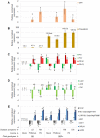Prosystemin overexpression induces transcriptional modifications of defense-related and receptor-like kinase genes and reduces the susceptibility to Cucumber mosaic virus and its satellite RNAs in transgenic tomato plants
- PMID: 28182745
- PMCID: PMC5300215
- DOI: 10.1371/journal.pone.0171902
Prosystemin overexpression induces transcriptional modifications of defense-related and receptor-like kinase genes and reduces the susceptibility to Cucumber mosaic virus and its satellite RNAs in transgenic tomato plants
Abstract
Systemin is a plant signal peptide hormone involved in the responses to wounding and insect damage in the Solanaceae family. It works in the same signaling pathway of jasmonic acid (JA) and enhances the expression of proteinase inhibitors. With the aim of studying a role for systemin in plant antiviral responses, a tomato (Solanum lycopersicum) transgenic line overexpressing the prosystemin cDNA, i.e. the systemin precursor, was inoculated with Cucumber mosaic virus (CMV) strain Fny supporting either a necrogenic or a non-necrogenic satellite RNA (satRNA) variant. Transgenic plants showed reduced susceptibility to both CMV/satRNA combinations. While symptoms of the non-necrogenic inoculum were completely suppressed, a delayed onset of lethal disease occurred in about half of plants challenged with the necrogenic inoculum. RT-qPCR analysis showed a correlation between the systemin-mediated reduced susceptibility and the JA biosynthetic and signaling pathways (e.g. transcriptional alteration of lipoxygenase D and proteinase inhibitor II). Moreover, transgenically overexpressed systemin modulated the expression of a selected set of receptor-like protein kinase (RLK) genes, including some playing a known role in plant innate immunity. A significant correlation was found between the expression profiles of some RLKs and the systemin-mediated reduced susceptibility to CMV/satRNA. These results show that systemin can increase plant defenses against CMV/satRNA through transcriptional reprogramming of diverse signaling pathways.
Conflict of interest statement
The authors have declared that no competing interests exist.
Figures




References
-
- McGurl B, Pearce G, Orozco-Cardenas M, Ryan CA. Structure, expression, and antisense inhibition of the systemin precursor gene. Science. 1992;255(5051):1570–3. - PubMed
MeSH terms
Substances
LinkOut - more resources
Full Text Sources
Other Literature Sources

